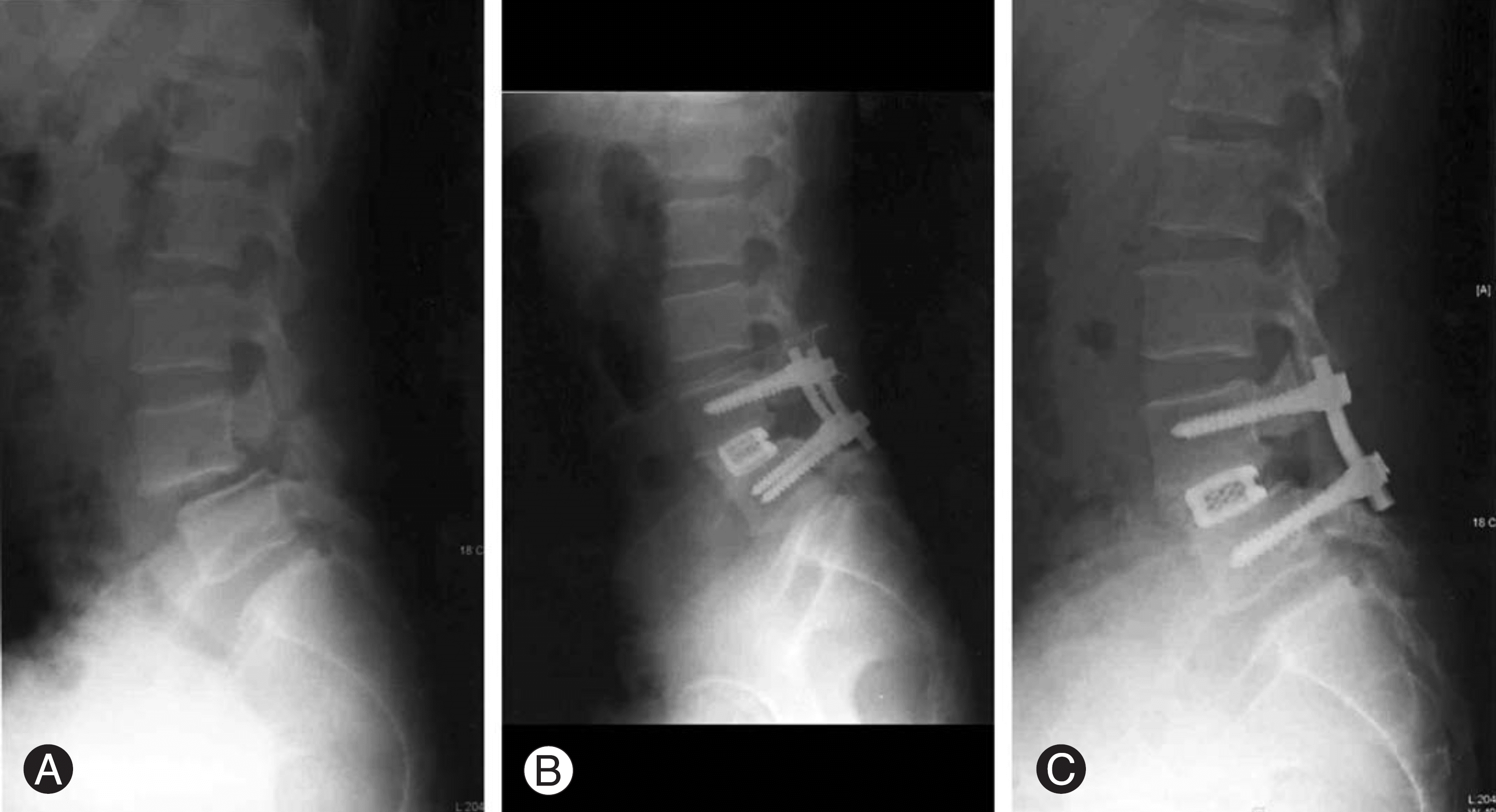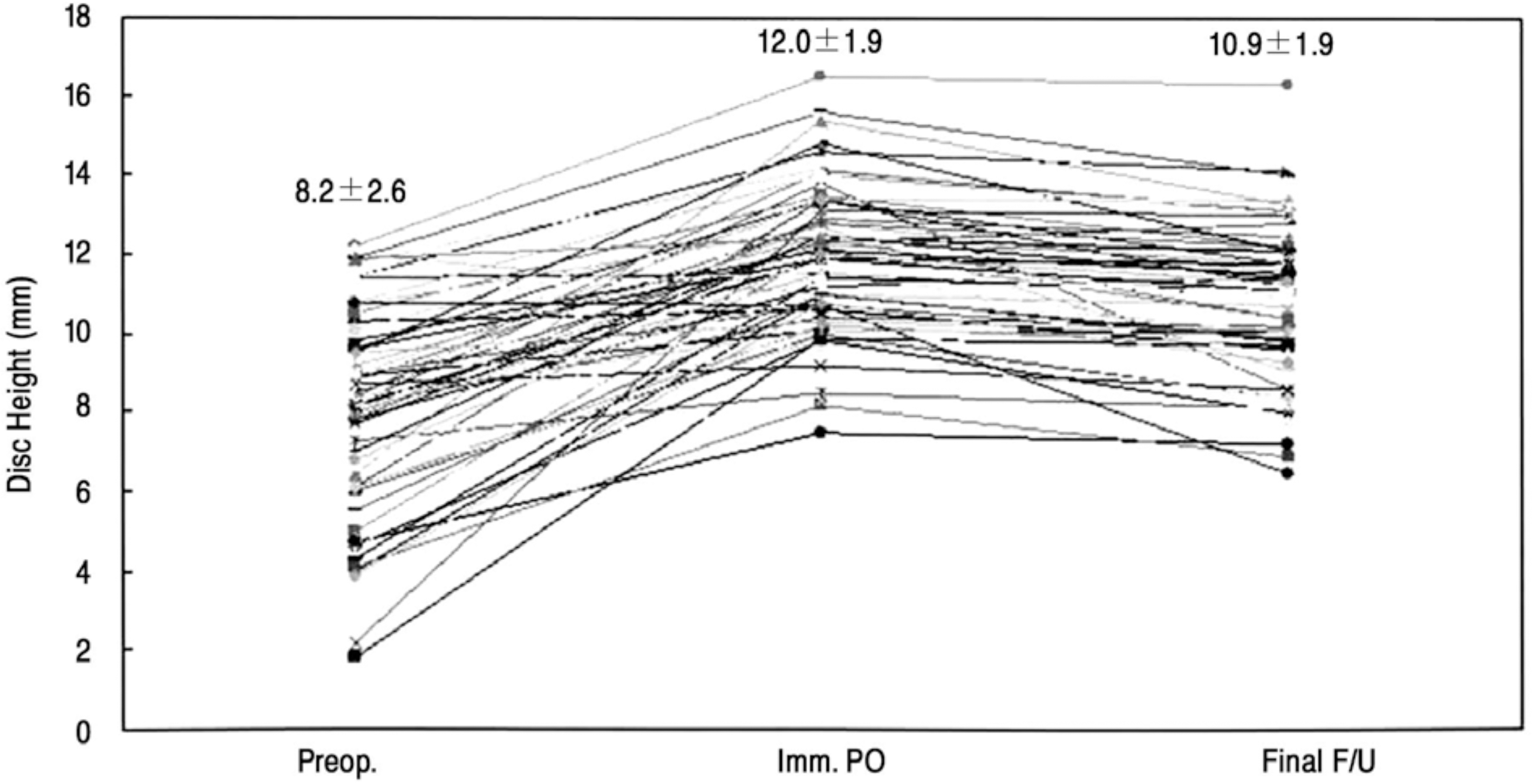Abstract
Study Design
A retrospective study to evaluate the results of posterior lumbar interbody fusion (PLIF) using titanium cages filled with morselized local bone.
Objective
To verify the clinical and radiological results of the PLIF procedure using rectangular titanium cages filled with morselized local bone.
Summary and literature Review
Stabilization of the spine can be achieved by interbody arthrodesis through the posterior approach. However many significant problems including bone graft collapse, resorption, nonunion, and iliac donor site morbidity caused by the classic PLIF procedure need to be solved. The use of local bone and a titanium cage might be a solution.
Materials and method
Fifty-nine patients(average age at surgery, 51.3 years), who underwent surgery for degenerated low back disease, were enrolled in this study. The average followup duration was 19.9 months. The radiological fusion status, intervertebral disc heights, visual analogue scales, clinical outcomes were evaluated.
Results
Forty-three (73%) patients were classified as complete-union, 16 (27%) patients as probable-union, and no patients were classified as non-union. The average intervertebral disc height increased by 3.7 mm at immediate postoperatively, and the average subsidence was 1.1 mm at the final followup. The average visual analogue scale decreased from 5.5 to 1.4 for back pain and from 6.6 to 0.8 for radicular pain. Nineteen (32%) and 28 (48%) patients were classified as excellent and good, respectively, according to clinical outcome assessment by Kim and Kim criteria. The complications encountered were a dural tear in 8 patients, partial root injury in 1, and upper adjacent segment instability during followup in 2.
Conclusion
PLIF using titanium cages filled with morselized local bone has the advantages of maintaining an intervertebral disc height, immediate stability, and the avoidance of donor site morbidity. However, longer-term results are needed, because the followup period of this study was relatively short
Go to : 
REFERENCES
1). Cloward RB. The treatment of ruptured intervertebral disc by vertebral body fusion. Indication, operative techniques and aftercare. J Neurosurg. 1953; 10:154–167.
3). Takeda M. Experience in posterior lumbar interbody fusion: Unicortical versus bicortical autologous grafts. Clin Orthop. 1985; 193:120–126.
4). Ma GW. Posterior lumbar interbody fusion with special-ized instruments. Clin Orthop. 1985; 193:57–63.

5). Brantigan JW, Steffee AD, Geiger JM. A carbon fiber implant to aid interbody fusion. Mechanical testing. Spine. 1991; 16:S277–285.
6). Simmon JW. Posterior lumbar interbody fusion with posterior elements as chip graft. Clin Orthop. 1985; 193:85–89.
7). Shin BJ, Kim GJ, Kwon H, et al. Results of PLIF using laminar chips in spinal lesions. J of Korean Soc Spine Surg. 1998; 5:284–292.
8). Shin BJ, Kim GJ, Ha SS, et al. Posterior lumbar interbody fusion using laminar bone block. J of Korean Soc Spine Surg. 1999; 6:110–116.
9). Kim NH, Kim DJ. Anterior interbody fusion for spondylolisthesis. Orthopaedics. 1991; 14(10):1069–1076.

10). Lin PM. Posterior lumbar interbody fusion: Complications and pitfalls. Clin Orthop. 1985; 193:90–102.
11). Hutter CG. Posterior intervertebral fusion. A 25-year study. Clin Orthop. 1983; 179:86–96.
12). Lin PM, Cautilli RA, Joyce MF. Posterior lumbar interbody fusion. Clin Orthop. 1983; 180:154–168.

13). Kai Y, Oyama M, Morooka M. Posterior lumbar interbody fusion using local facet joint autograft and pedicle screw fixation. Spine. 2004; 29:41–46.

14). Arai Y, Takahashi M, Kurosawa H, Shitoto K. Com-parative study of iliac bone graft and carbon cage with local bone graft in posterior lumbar interbody fusion. J Orthop Surg. 2002; 10(1):1–7.

Go to : 
Figures and Tables%
 | Fig. 2.A 43-year-old male patient with L4 isthmic spondylolisthesis and bilateral L4 radiculopathy. (A) Preoperative lateral view shows moderate anterior slipping of L4, decrease in disc height at L4-5. (B) Lateral view after surgery shows reduction of the slip, restoration of disc height. (C) At 3 year after surgery, lateral radiograph shows solid fusion and maintainance of reduction. |
Table 1.
Patient profile
Table 2.
Criteria for Clinical Result (by Kim & Kim)




 PDF
PDF ePub
ePub Citation
Citation Print
Print



 XML Download
XML Download